
Exploring Serverless Architecture: Important Benefits and Challenges [2024]
Apr 24, 2024 6 Min Read 624 Views
(Last Updated)
As a full-stack developer or a backend developer, how many things can you handle at the same time? You already have so much on your plate and in addition to that, if you have to maintain the servers in which your data is getting stored, then that’s an additional headache.
But what if there’s an option for you to omit the process of looking after the servers? You heard it right! With serverless architecture, you necessarily don’t have to worry about servers anymore. But what is it? How does it work?
The answers to those questions lie in this article so read it till the end to understand everything about serverless architecture including its benefits and challenges.
So, shall we start?
Table of contents
- What is Serverless Architecture?
- How is Serverless Architecture Used?
- Web Applications and APIs
- Data Processing
- IoT Applications
- Event-Driven Systems
- Scheduled Tasks
- Benefits of Serverless Architecture
- Cost Efficiency
- Scalability
- Faster Time to Market
- Reduced Operational Concerns
- Improved Flexibility
- Challenges of Serverless Architecture
- Cold Starts
- Monitoring and Debugging
- Vendor Lock-In
- Security Concerns
- Limited Control
- Statelessness
- Get Started With Serverless Architecture
- Start Small
- Choose the Right Tools
- Plan for Cold Starts
- Manage Vendor Lock-In
- Embrace Best Practices
- Conclusion
- FAQs
- How does serverless architecture work?
- What are the challenges in debugging serverless applications?
- What programming languages are supported in serverless architectures?
- Can serverless architecture be used for backend services?
- How do I choose between serverless and traditional cloud services?
What is Serverless Architecture?
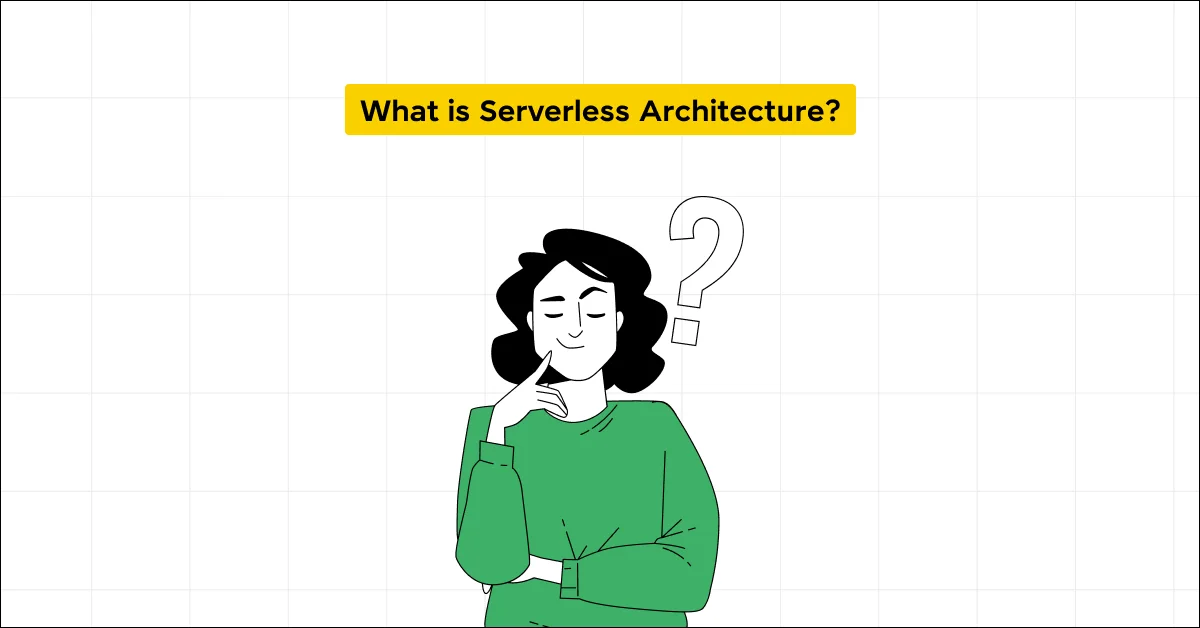
Let’s understand more about the term “serverless architecture.” At first glance, you might think it sounds like a world without servers, but that’s not quite right. Servers are still very much part of the picture.
The “serverless” in serverless architecture means that you, the person or company building an application, don’t have to worry about those servers. Instead, the heavy lifting of managing these servers is handled by your cloud provider like AWS, Microsoft Azure, etc.
If you are having a wedding, you won’t necessarily do everything, right? For cooking, cleaning, and serving your guests, you hire a catering service that takes care of all that in your place. You just tell them how many guests and what food you need, and they take care of everything else. Serverless architecture works similarly.
You provide the code—the instructions for what your application needs to do—and the cloud provider runs it on their servers. They make sure there’s enough power for your application to run smoothly, whether it’s being used by ten people or ten thousand.
So, in simple terms, serverless architecture lets you focus on creating and improving your application without worrying about the underlying infrastructure.
Learn More: 10 Best Database Management Systems For Software Developers
How is Serverless Architecture Used?
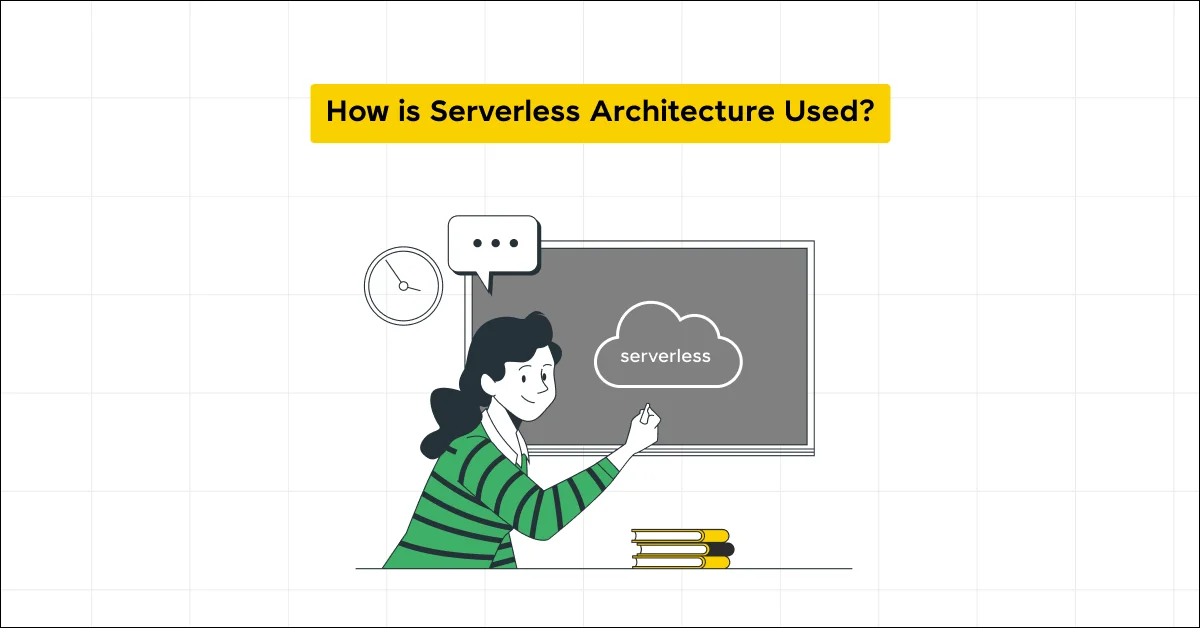
Now that we understand what serverless architecture is, let’s talk about how it’s used. But before we move on, you must know the basics of full-stack development as that lays the foundation for your knowledge in serverless architecture.
If you don’t know the basics, consider enrolling in a certified online Full Stack Development course by a recognized institution that teaches you everything about the subject and lets you gain a strong sense of knowledge in serverless architecture.
Let us now understand how serverless architecture is used by professionals. Think of serverless architecture like a tool in a toolkit; it’s not right for every job, but for certain tasks, it’s incredibly efficient and effective.b
1. Web Applications and APIs
Imagine you’re building an e-commerce site. Each time a customer accesses your website, serverless architecture functions can handle their requests—like displaying products or processing orders—without any need for you to manage the servers where your website is hosted.
Essentially, these functions wake up, do their job (like retrieve product data), and then go back to sleep, only charging you for the short time they were awake.
Also Read: Use ReactJS to Fetch and Display Data from API – 5 Simple Steps
2. Data Processing
Serverless architecture is great for jobs that need to happen automatically in response to data changes. For example, if you run a news site, you might want serverless architecture functions to automatically resize photos uploaded by reporters or even moderate comments in real-time.
The function runs whenever a photo is uploaded or a comment is posted, processes the data, and then shuts down until it’s needed again.
3. IoT Applications
With the Internet of Things (IoT), you have devices everywhere—a fitness tracker on your wrist, a smart fingerprint sensor in your home, or a security camera at your front door.
Serverless architecture can manage the data coming from all these devices efficiently. Each time a device sends new data, a serverless function can process it right away, for instance, updating your step count or adjusting your home’s temperature, without any ongoing server monitoring on your part.
Must Explore: Top 17 Best IoT Project Ideas
4. Event-Driven Systems
In any system where a specific event prompts an action, serverless architecture is a natural fit. Let’s say you own a business that needs to send out an email confirmation every time an order is placed. You can set up a serverless function to automatically handle sending these emails whenever a new order comes through your system.
5. Scheduled Tasks
Even tasks that need to happen on a regular schedule, like daily reports or weekly backups, can be managed by serverless functions. These functions can be programmed to run at specific times, perform the task, and then shut down again until the next scheduled time.
The beauty of using serverless architecture in these scenarios is its simplicity and cost-effectiveness. You don’t need to keep a server running 24/7. Instead, you utilize resources only when your functions are actively running.
This not only saves money but also reduces the time you spend managing server hardware and software.
Explore: Top 10 Full-Stack Developer Frameworks in 2024
Benefits of Serverless Architecture
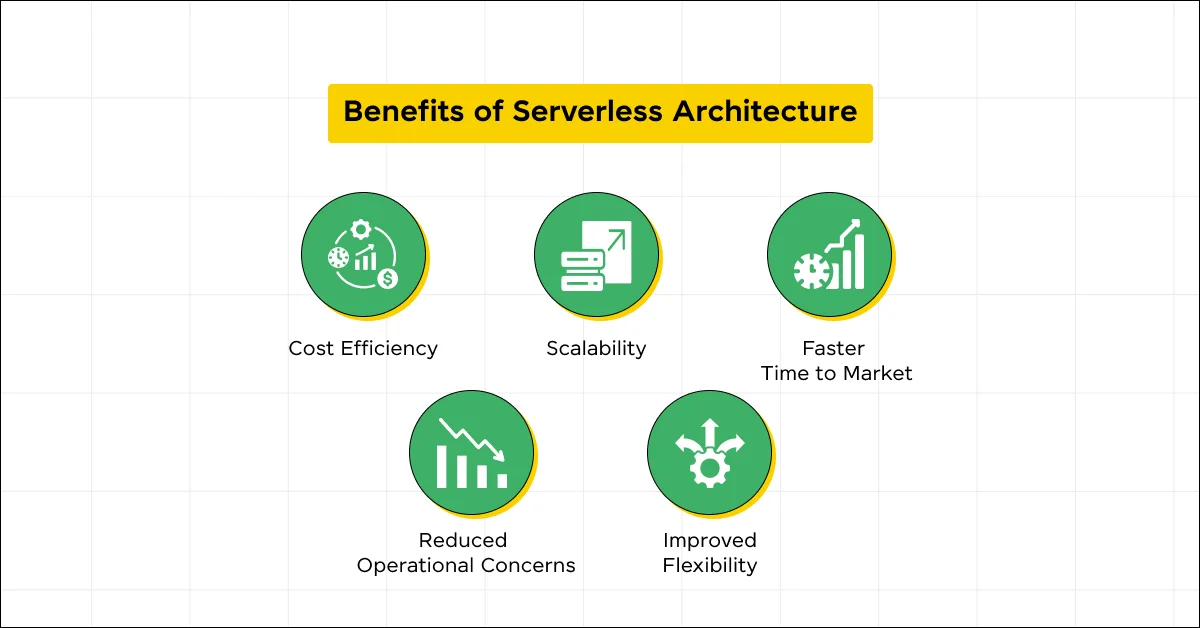
Serverless architecture offers several advantages, making it an attractive choice for many developers and businesses. Here’s how it can make a difference in your projects:
1. Cost Efficiency
One of the biggest benefits of going serverless is cost savings. Imagine only paying for your home electricity when you’re using your appliances.
Similarly, with serverless architecture, you pay only when your functions are running (pay-as-you-go model). This can lead to substantial cost reductions, especially for applications with variable usage patterns.
2. Scalability
Scalability is another major perk. In traditional server setups, you might need to predict how much traffic your application will get and then buy enough server power to handle the peak.
This often means paying for capacity that goes unused during off-peak times. Serverless functions, on the other hand, automatically scale up when there are more requests and scale down when requests drop, ensuring efficient use of resources and maintaining performance without manual intervention.
Also Explore: Horizontal vs Vertical Scaling for Efficient System Design
3. Faster Time to Market
Serverless architecture can also speed up the process of getting your applications from concept to launch. Since the cloud provider manages all the infrastructure, you and your team can focus on writing code and creating features rather than setting up and maintaining servers.
This leads to quicker iterations, faster feedback from users, and a shorter time to market.
4. Reduced Operational Concerns
With serverless architecture, you don’t have to worry about the operational hassles of running servers, such as patching, securing, or updating the underlying hardware and software.
All these tasks are taken care of by the cloud provider. This not only reduces the burden on your IT teams but also minimizes the risk of downtime due to hardware failures or security vulnerabilities.
5. Improved Flexibility
Serverless architecture supports a microservices architecture, which means you can update components of your application independently rather than redeploying entire applications.
This flexibility can be a huge advantage in a competitive business environment where being able to adapt quickly to market changes or customer feedback can be crucial.
Explore More: 8 Top Full Stack Web Developer Coding Projects For You!
Challenges of Serverless Architecture
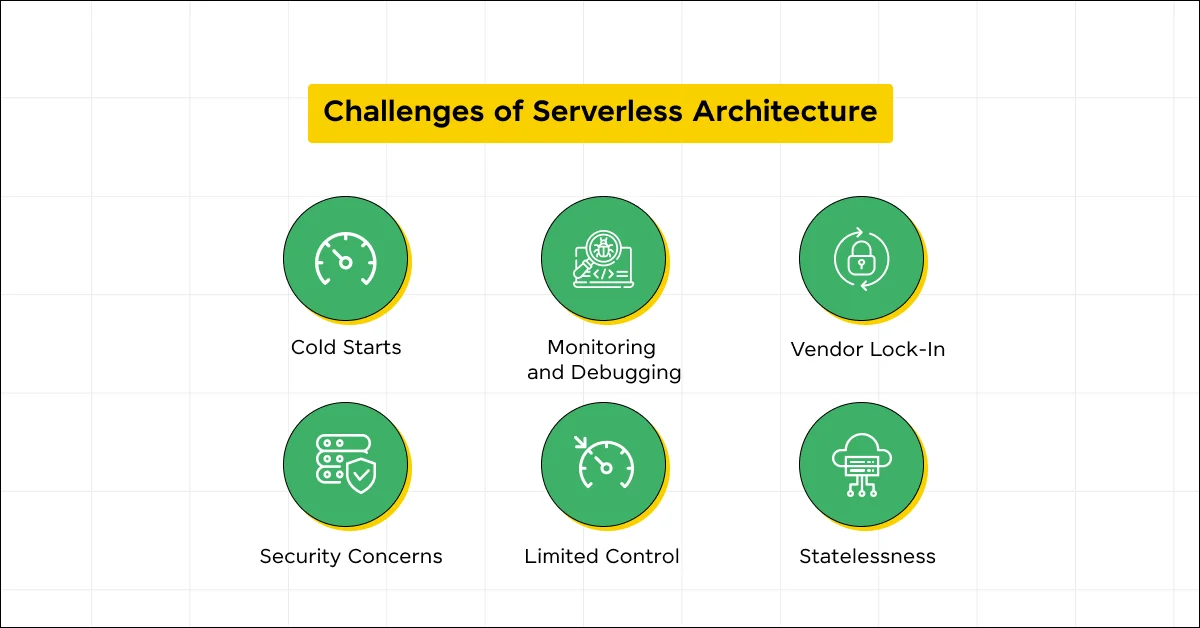
While serverless architecture offers numerous benefits, it also presents some unique challenges that are important to consider and you need to be aware of. Understanding these challenges can help you better navigate the landscape of serverless computing.
1. Cold Starts
Imagine you have a car that is stuck in the winter. When you try to start it after it’s been sitting in the cold, it takes a bit longer to warm up and run smoothly. A similar phenomenon happens with serverless functions, known as a “cold start”.
When a function hasn’t been used for a while, it takes extra time to initiate, which can slow down the response time the first time it’s triggered after being idle. This can be a significant issue for applications where immediate response is crucial.
2. Monitoring and Debugging
If you’ve ever tried to fix a gadget without a manual, you know how tricky troubleshooting can be. Serverless applications can be even more challenging to debug and monitor because they’re not running continuously.
Traditional tools may not work as effectively in a serverless environment, making it harder to track down issues when they arise. You often need specialized monitoring tools that understand the serverless framework to get a clear picture of what’s happening.
Also Read: Best Tips and Tricks for JavaScript Debugging Skills [2024]
3. Vendor Lock-In
Choosing a serverless provider is a bit like getting a cell phone plan. Once you’ve got a phone that works with one provider, switching to another can be a hassle.
Similarly, serverless functions are often closely tied to the specific cloud provider’s infrastructure and services. This makes it difficult to move your application to another provider without rewriting or adapting a significant portion of your code.
4. Security Concerns
With serverless, your application is spread out across many different functions, which can make it harder to ensure consistent security practices. It’s like trying to keep track of several pets at the park—each running in different directions.
You must manage security at each function level, which can be complex, especially when dealing with large applications that handle sensitive data.
Find Out Top Skills To Become a Full-Stack Developer in 2024
5. Limited Control
Using serverless computing is similar to renting an apartment rather than owning a house. You have less control over the underlying architecture. If you need specific software configurations or particular versions of operating systems, serverless might not be flexible enough for your needs.
This lack of control can be limiting for some advanced or highly customized applications.
6. Statelessness
Serverless functions are stateless, meaning each function call acts as if it’s the first time it’s being run, with no knowledge of previous interactions.
If your application needs to maintain a state over multiple transactions, managing this can become complex. You often have to rely on external systems to store state, which can add latency and complexity to the application.
Understanding these challenges is crucial in deciding whether serverless architecture is right for your project or not. With proper planning and the right tools, many of these obstacles can be managed effectively.
Also Learn: Interaction Between Frontend and Backend: Important Process That You Should Know
Get Started With Serverless Architecture
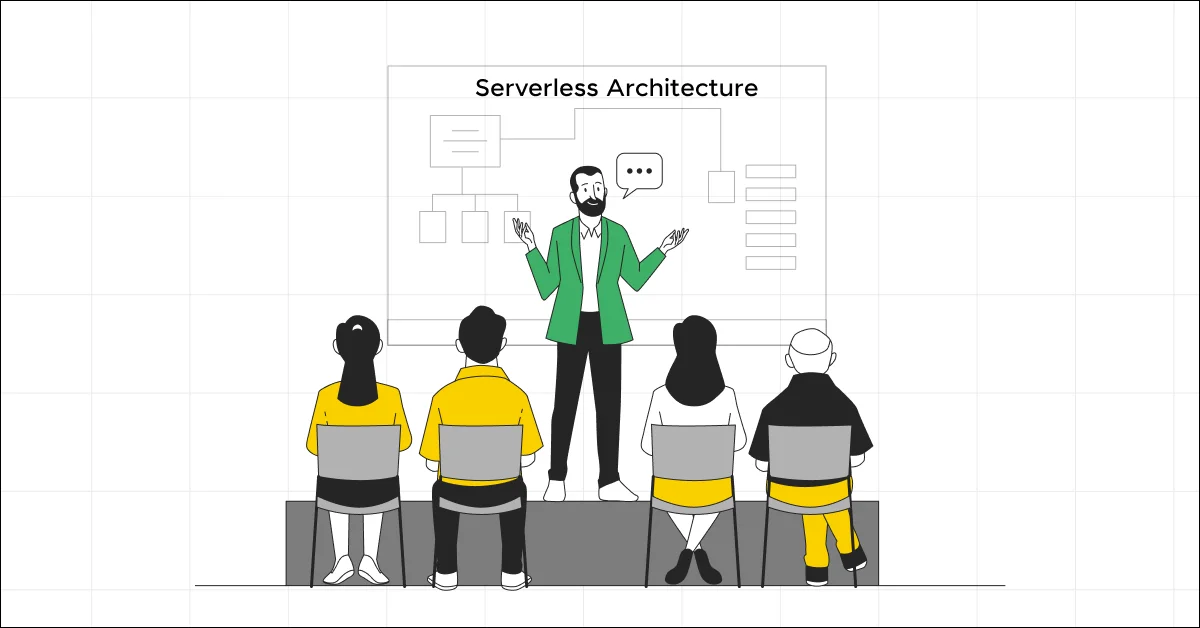
Adopting serverless architecture can feel a bit like learning to drive in a new city. The roads (or rules) aren’t what you’re used to, but with the right navigation tools and some strategic planning, you can get where you need to go efficiently and safely.
Here’s how to successfully get started with the world of serverless architecture.
1. Start Small
If you’re new to serverless, don’t overhaul your entire system at once. Start with a small, non-critical project. This could be a new feature, a standalone application, or a background task that doesn’t disrupt your main operations.
This approach allows you to learn the ropes, understand the nuances, and evaluate the technology’s impact on your workflow and products without significant risk.
2. Choose the Right Tools
Just as a good GPS app makes navigating a new city easier, the right tools can simplify working with serverless architectures.
Invest in specialized tools for monitoring, debugging, and security that are designed for serverless environments. These tools can help you keep a close eye on what’s happening with your applications, manage performance effectively, and maintain robust security standards.
Also Read: The Ultimate Guide to Real-World Full-Stack Development Applications
3. Plan for Cold Starts
To mitigate the impact of cold starts, you can use strategies like keeping the functions warm. This involves invoking your functions at regular intervals to ensure they are ready to respond quickly when needed. Additionally, choosing a programming language and runtime that are optimized for quick startup times can also help.
4. Manage Vendor Lock-In
Be strategic about the services and features you choose to avoid getting too locked into one provider’s ecosystem. Where possible, design your application to be portable, using containerization or relying on abstraction layers that make it easier to switch providers or operate across multiple platforms.
5. Embrace Best Practices
Stay informed about the best practices in serverless architecture. This includes everything from how to structure your code to how to handle logging and exception management effectively.
The serverless community is vibrant and continuously evolving, with plenty of resources, tutorials, and forums where you can learn from others’ experiences.
If you want to learn more about serverless architecture in full-stack development, then consider enrolling in GUVI’s certified Full Stack Development Career Program which not only gives you theoretical knowledge but also practical knowledge with the help of real-world projects.
Also Read: The Role of Serverless Computing in Backend Development
Conclusion
In conclusion, serverless architecture offers a revolutionary approach to building and deploying applications by allowing developers to focus more on coding and less on managing servers.
This model brings considerable benefits, such as cost efficiency, scalability, and quicker time to market, making it an attractive option for many projects. However, challenges like cold starts, vendor lock-in, and security issues require thoughtful planning and strategic management.
Ultimately, serverless architecture stands out as a powerful solution for developing modern, efficient, and adaptable applications.
Must Read: Top Full Stack Development Trends for 2024: What to Expect
FAQs
1. How does serverless architecture work?
In serverless architecture, developers write functions that are triggered by specific events (like HTTP requests or database updates). The cloud provider runs these functions as needed, handling scaling and server maintenance.
2. What are the challenges in debugging serverless applications?
Debugging serverless applications can be complex due to their distributed nature and the ephemeral runtime of functions, requiring specialized tools and practices.
3. What programming languages are supported in serverless architectures?
Most cloud providers support a wide range of programming languages, including JavaScript (Node.js), Python, Java, C#, Ruby, and Go.
4. Can serverless architecture be used for backend services?
Yes, serverless is particularly beneficial for backend services such as APIs, microservices, and automated tasks where scaling and maintenance are managed automatically.
5. How do I choose between serverless and traditional cloud services?
The choice depends on specific project requirements, such as cost constraints, scalability needs, and the complexity of the application. Serverless is ideal for variable workloads and rapid development cycles.






























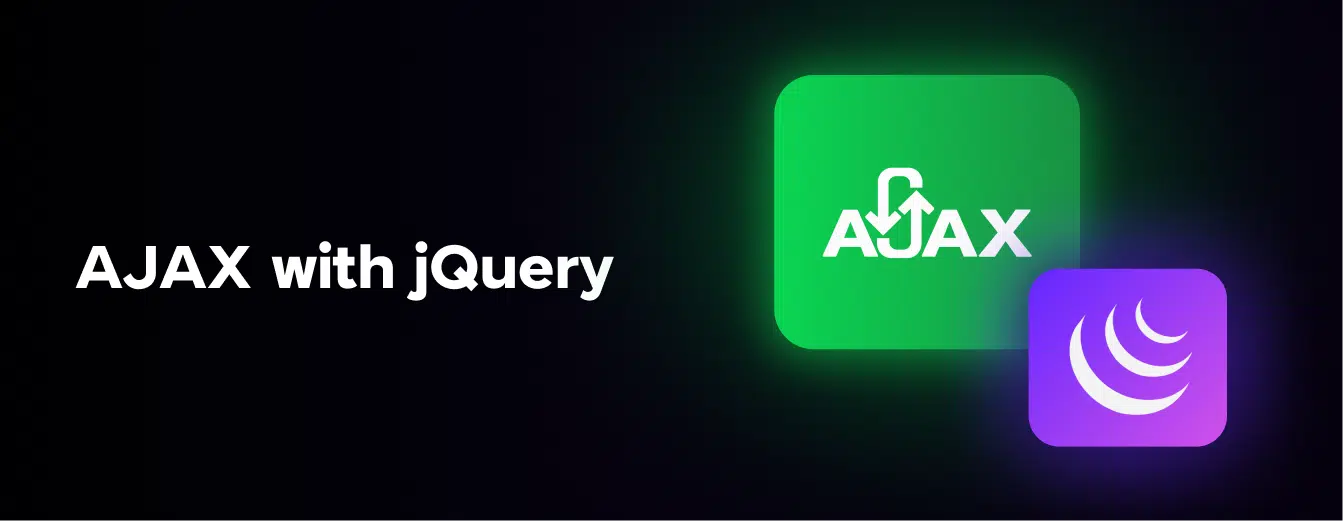

Did you enjoy this article?